Listen to audio version of this blog post:
Land use classification plays a key role in urban planning, resource management, and environmental monitoring. Previously dependent on manual surveys and aerial imagery, the advent of Earth observation technologies, remote sensing, and Geographic Information Systems (GIS) has significantly changed our methods of land use classification.
But how can you create a land use classification map from raw satellite imagery? What are the practical steps, challenges and opportunities?
In this post, we will start a “supervised” land use classification utilizing Sentinel-2 satellite imagery with a 10-meter resolution, and we will concentrate on the specifics of the procedure, including categories, legends, and additional details. This semi-automatic method takes advantage of open data (Copernicus program) and Earth observation to provide a perspective view.
Background : The Sentinel-2 Satellite and Open Data
Availability of Sentinel-2 imagery is the key source of the Copernicus program, a significant advancement in Earth observation. Its multispectral sensor takes images in different spectral bands, providing a sharper view of the Earth’s surface. The adoption of open data stands for transparency and makes this important information widely available, benefiting researchers, planners, and the public. This abundance of open data has expanded the possibilities for land use classification.
Earth Observation and Remote Sensing Techniques
Earth observation and remote sensing are fundamental for the classification of land use. These technologies enable the collection of terrestrial and atmospheric data without being on-site.
Earth Observation is the practice of collecting data about our planet through satellites and sensors. The Earth Observation Browser is an online tool that facilitates access to a vast array of Earth observation data and imagery. It allows for the exploration and analysis of important environmental data, supporting diverse applications such as disaster response, environmental stewardship, and scientific investigation.
Sentinel-2 imagery: a valuable data source for land use analysis
Sentinel-2 supports land use data extraction in a number of ways. It offers a broad spectrum of data, capturing both visible and non-visible light, allowing the identification of key land features like vegetation, water bodies, and urban areas, which is all crucial for the classification task.
Scene classification was developed to distinguish between cloudy pixels, clear pixels, and water pixels of Sentinel-2 data and is a result of the European Space Agency’s (ESA) scene classification algorithm.
Twelve different classifications are provided, including:
- Various classes of clouds
- Vegetation
- Soils/desert
- Water
- Snow and ice
This scene classification algorithm does not constitute a land cover classification map in a strict sense but it helps us to understand the steps we take to state the area we are classifying is in fact what we guess it is. The closer we are to ground truth, the more accurate the classification will be.
At LuxCarta, we use Sentinel-2 imagery as the basis for many our land use classification maps. By building on the data from the scene classification algorithm (as well as RGB imagery), we can accelerate the process of identifying different types of land use.
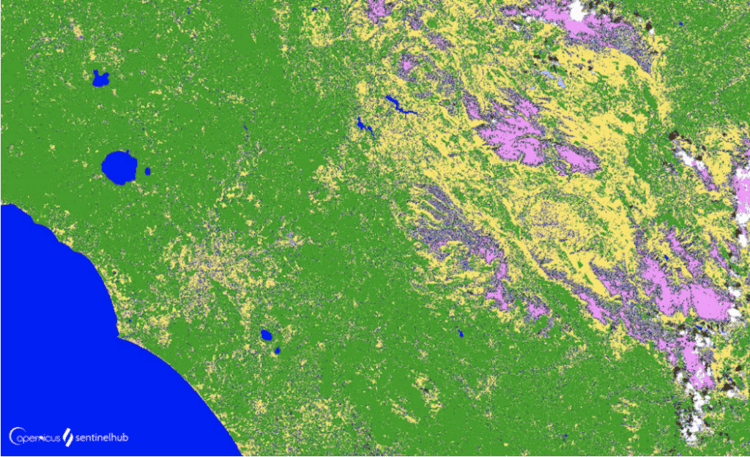
Typologies in Land Use Classification Maps
Land use classification involves the categorization of land into distinct types based on its primary function or purpose. This classification plays a pivotal role in urban planning, resource management, and environmental assessment among other industries.
Common land use and land cover classifications include:
- Residential areas
- Industrial zones
- Agricultural lands
- Water bodies
- Forests
- And more
The typologies are refined to fit specific project needs, allowing for precise assessment and decision-making.
In the realm of land use classification, an array of menus and parameters come into play during image processing. The menus facilitate the selection of spectral bands that are most relevant to the classification objectives. Parameters are carefully chosen to calibrate the imagery for analysis. This precision is essential to ensure that the processed images reflect the true nature of the land surface, allowing for accurate classification.
One particularly useful piece of information we get from Sentinel-2 are ‘spectral signatures’. These show the variation of the radiation reflected by objects as a function of wavelength. This physical behavior is considered in multispectral analyses to recognize certain elements in the images.
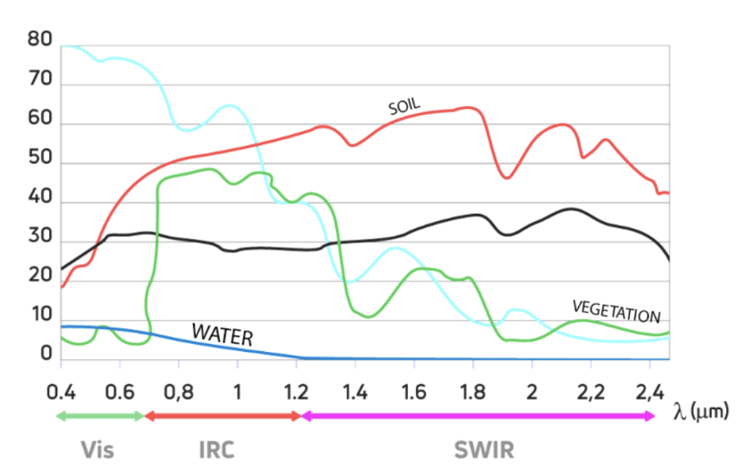
Now let’s look at three different types of land use, water, soil, and vegetation.
Related: Creating digital surface models with satellite imagery
Sentinel-2 Applications in Land Use Classification
We can use Sentinel-2 land cover classification data to extract valuable insights from Sentinel-2 imagery. Here are three examples.
Example 1 : Extracting/classifying WATER
Not all pixels in which we find water will have the same spectral signature, but it will look similar to this one. This type of surface has an inverse signature to that of the ground, since the highest reflectivity of water is in the visible bands, reducing towards the near-infrared.
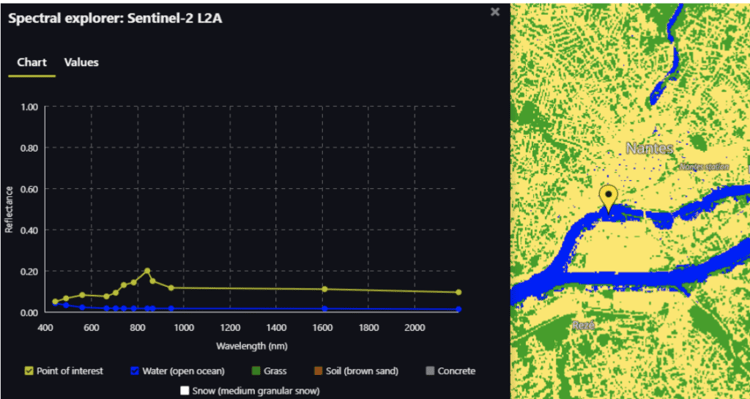
Example 2 : Extracting/classifying SOIL
The spectral signature of the soil is more complicated because it is influenced by its structure, texture, moisture content, and composition of it. This signature is quite flat and ascending in shape.
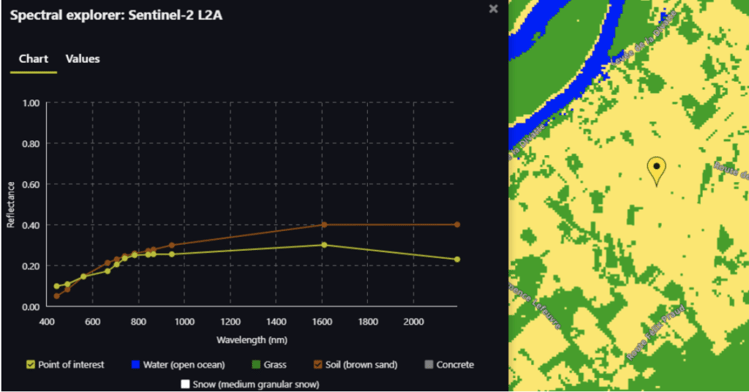
Example 3 : Extracting/classifying VEGETATION
Healthy vegetation shows low values in the visible spectrum and its highest reflectivity is in the near-infrared due to low energy absorption. It is lower in the mid-infrared due to the absorbing effect of water on the leaves.
If we look at this signature obtained from a Sentinel 2 image, we can see that there is greater reflectivity corresponding to the near-infrared (0,7-1,2 nm). This decreases into the mid-infrared.
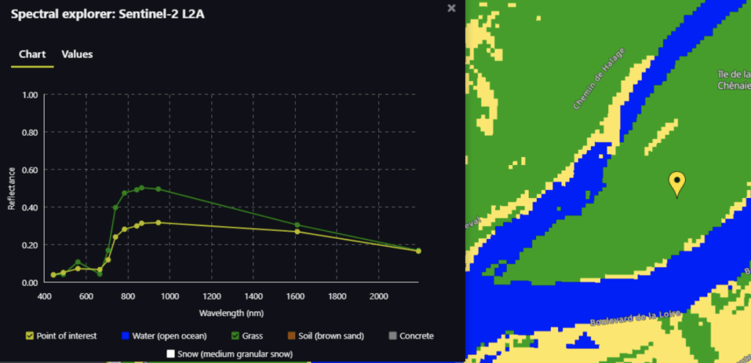
There are other spectral signatures of other classes to consider too - such as clouds or cement, for example.
Once we have finished land use data extraction, we now need to categorize these classes and symbolize them in maps.
GIS Land Use Mapping Techniques : Legends and Data Visualization
Legends are a critical component of land use classification. They provide an essential reference for understanding the output of the classification process. Legends describe the categories into which land is classified, allowing users to interpret the data. By associating color or symbol representations with specific land types, legends make it easier to visualize and communicate the results, ensuring that stakeholders can make informed decisions.
Because maps are representations of the real world, cartographers will use symbols and colors to tell the reader what they are mapping. Depending on your needs, you can either create your own land use classification code, or use standardized ones. The figure below shows some of the standard GIS land use mapping color codes:

GIS learning: DEM vs DTM vs DSM: which mapping model is right for you?
And finally, integration with other GIS layers
Geographic Information Systems (GIS) are the backbone of land use classification. GIS software facilitates the manipulation, analysis, and visualization of data, enabling the transformation of raw Sentinel-2 imagery into meaningful information. The overlay of various data layers allows for the creation of land use maps, integrating geographical information to inform urban development, agriculture, forestry, and environmental management.
At LuxCarta, we combine machine learning and human expertise to enable supervised classification in GIS. This allows us to dramatically increase the area we can classify when creating land use or land cover maps.
We combine land use classification data from Sentinel-2 imagery with other data sources to create many kinds of maps, including:
- Our Region Planner, Urban Planner and City Planner maps
- Population density maps (PopMaps)
- Smart city and solar maps
- RF planning maps
- Clutter maps
- And much more
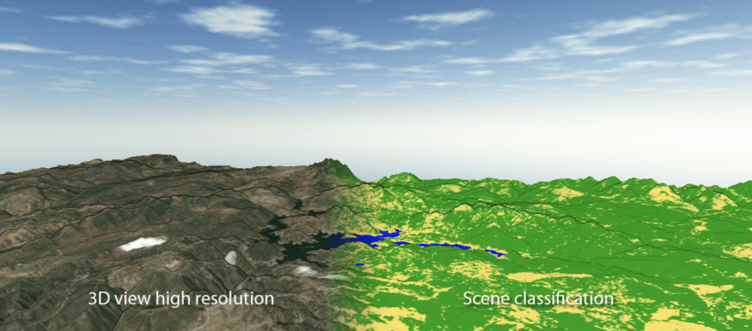
An exciting time in land use and land cover classification
The integration of Sentinel-2 imagery with open data, remote sensing and GIS, is driving the evolution of land use classification. This approach offers a first-hand understanding of the Earth’s dynamic surface.
Technology, data, and expertise synergize to revolutionize land use perception and management, offering valuable insights for sustainable development, resource management, and environmental conservation. Researchers, policymakers, and Earth observation technologies are continually expanding the journey of land use classification.
At LuxCarta, we’re helping researchers and businesses in multiple industries to map their world. Do you have a land use or land cover classification project you need support with? Contact us today.
